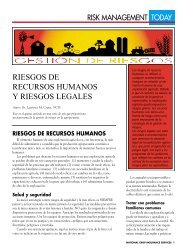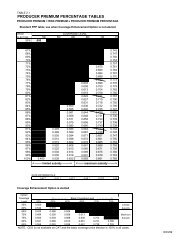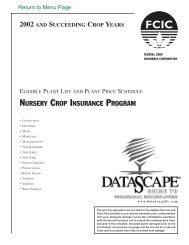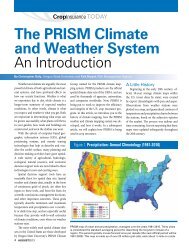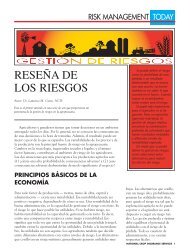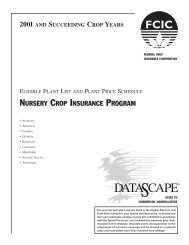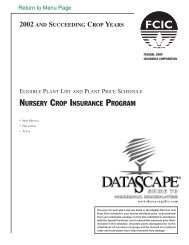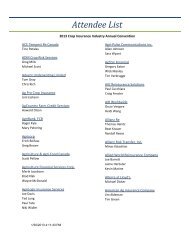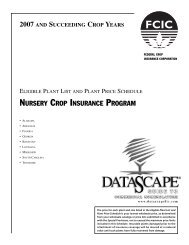How Do Farmers Manage Risk When it Comes in So Many Forms
How Do Farmers Manage Risk When it Comes in So Many Forms
How Do Farmers Manage Risk When it Comes in So Many Forms
You also want an ePaper? Increase the reach of your titles
YUMPU automatically turns print PDFs into web optimized ePapers that Google loves.
CropInsuranceTODAY<strong>How</strong> <strong>Do</strong> <strong>Farmers</strong> <strong>Manage</strong> <strong>Risk</strong><strong>When</strong> It <strong>Comes</strong> <strong>in</strong> <strong>So</strong> <strong>Many</strong> <strong>Forms</strong>?By Dave Ray, North Bridge CommunicationsIt’s often said that farm<strong>in</strong>g is a risky bus<strong>in</strong>ess, and farmers would likelyargue that this is a gross understatement. While the risks caused by MotherNature make the most news, there are many other risks <strong>in</strong>volved that farmersmust prepare to manage.In 2011, farmers saw a str<strong>in</strong>g of major natural disasters, <strong>in</strong>clud<strong>in</strong>g earlyfreezes, record floods, droughts, wildfires and hurricanes. Then, 2012 dealtfarmers the worst drought <strong>in</strong> decades, w<strong>it</strong>h a major<strong>it</strong>y of the cont<strong>in</strong>ental U.S.experienc<strong>in</strong>g some level of drought dur<strong>in</strong>g most of the grow<strong>in</strong>g season. Andthe drought cont<strong>in</strong>ues <strong>in</strong> 2013, w<strong>it</strong>h more than 60 percent of the cont<strong>in</strong>entalUn<strong>it</strong>ed States rema<strong>in</strong><strong>in</strong>g <strong>in</strong> some degree of drought.The economic nature of farm<strong>in</strong>g, which consists of many people produc<strong>in</strong>gone common product w<strong>it</strong>h lim<strong>it</strong>ed buyers, is <strong>it</strong>self susceptible torisk, s<strong>in</strong>ce <strong>in</strong>dividual producers have very l<strong>it</strong>tle, if any, <strong>in</strong>fluence over theprices they receive for their f<strong>in</strong>al products or what they pay for their production<strong>in</strong>puts. <strong>When</strong> you add this <strong>in</strong>abil<strong>it</strong>y to <strong>in</strong>fluence a price to thevolatil<strong>it</strong>y of the world market—where the price of a commod<strong>it</strong>y changes bythe m<strong>in</strong>ute—<strong>it</strong>’s easy to understand why farmers are always th<strong>in</strong>k<strong>in</strong>g of waysto manage their risk.There are also the f<strong>in</strong>ancial constra<strong>in</strong>ts of farm<strong>in</strong>g, which is very cap<strong>it</strong>al<strong>in</strong>tensive. These constra<strong>in</strong>ts are so great that <strong>it</strong>’s becom<strong>in</strong>g <strong>in</strong>creas<strong>in</strong>gly difficultfor younger farmers to enter the bus<strong>in</strong>ess w<strong>it</strong>hout an endowment ofwork<strong>in</strong>g cap<strong>it</strong>al from a f<strong>in</strong>ancial backer, usually a bank.Thankfully, there are a number of tools available, and widely used, tomanage the economic, structural and environmental risks of farm<strong>in</strong>gand ranch<strong>in</strong>g. While crop <strong>in</strong>surance is the most ubiqu<strong>it</strong>ous risk managementtool used by farmers—86 percent of total planted acres <strong>in</strong> 2012CROPINSURANCE TODAY ® 27
were <strong>in</strong>sured—there are other tools that manyfarmers use as well. This article will provide abroad overview of these tools, exam<strong>in</strong><strong>in</strong>gwhere they are useful, the risks they can andcannot m<strong>it</strong>igate, and will assess their lim<strong>it</strong>s andoverall value to farmers.Agricultural Practices1. Crop Rotation. Crop rotation is the practiceof grow<strong>in</strong>g different types of crops on the samefield <strong>in</strong> different years or grow<strong>in</strong>g seasons. Oneof the most common crop rotations <strong>in</strong> the U.S. is<strong>in</strong>terchang<strong>in</strong>g corn w<strong>it</strong>h soybeans.Advantages: Crop rotation confers variousbenef<strong>it</strong>s to the soil, as well as replenish<strong>in</strong>g n<strong>it</strong>rogen,m<strong>it</strong>igat<strong>in</strong>g the buildup of pathogens and improv<strong>in</strong>gsoil structure.Disadvantages: Crop rotation does not fullym<strong>it</strong>igate weather-related risks.Crop and locationdiversification canhedge aga<strong>in</strong>st localizedweather-related crop losses.Grow<strong>in</strong>g multiple cropsmay help reduce <strong>in</strong>comevariabil<strong>it</strong>y by provid<strong>in</strong>gdifferent sources of revenue.2. Crop Diversification. Crop diversification is astrategy whereby farmers diversify geographically,or by crops, or both.Advantages: Crop and location diversificationcan hedge aga<strong>in</strong>st localized weather-relatedcrop losses. Grow<strong>in</strong>g multiple crops may help reduce<strong>in</strong>come variabil<strong>it</strong>y by provid<strong>in</strong>g differentsources of revenue.Disadvantages: Farm<strong>in</strong>g on several tracts ofland that are diverse geographically and grow<strong>in</strong>gmultiple crops can be very cap<strong>it</strong>al <strong>in</strong>tensive andreduce economies of scale, thereby rais<strong>in</strong>g productioncosts.3. Seed Varieties. Hybrid seed varieties havebeen developed that produce plants that are tolerantto different k<strong>in</strong>ds of stresses.Advantages: The use of hybrids can m<strong>it</strong>igatecerta<strong>in</strong> weather risks, like drought, repel pests orproduce plants that have tolerance to pesticides28 MAY2013and the presence of salt or other compounds <strong>in</strong>the soil.Disadvantages: Hybrids tend to be more expensivethan regular varieties, and if unnecessary,their use is not cost effective.4. Irrigation. Irrigation is the practice ofbr<strong>in</strong>g<strong>in</strong>g water to plants us<strong>in</strong>g various methods,<strong>in</strong>clud<strong>in</strong>g flood<strong>in</strong>g the fields, overhead,pivot-irrigation and drip irrigation.Advantages: Irrigation can be used to <strong>in</strong>creaseyields.Disadvantages: Irrigation is not alwaysenough to combat a severe drought, and can bevery costly due to the cost of pump<strong>in</strong>g and distribut<strong>in</strong>gwater. Irrigation does l<strong>it</strong>tle to addressother weather anomalies, like hurricanes or hailstorms. It can also make a crop more expensiveto produce.5. No-Till Plant<strong>in</strong>g. No-till plant<strong>in</strong>g is a wayof plant<strong>in</strong>g crops w<strong>it</strong>hout break<strong>in</strong>g the soilthrough tillage. This practice <strong>in</strong>creases theamount of organic matter and water ma<strong>in</strong>ta<strong>in</strong>ed<strong>in</strong> the soil while decreas<strong>in</strong>g overall erosion.Advantages: No-till plant<strong>in</strong>g helps the soilreta<strong>in</strong> <strong>it</strong>s moisture content and structure, thusimprov<strong>in</strong>g the productiv<strong>it</strong>y of the soil. It also reducescosts and allows a farmer to farm moreacres than under conventional tillage. Precisionagriculture often makes no till even moreefficient.Disadvantages: No-till plant<strong>in</strong>g can offersome benef<strong>it</strong> <strong>in</strong> drought, but does l<strong>it</strong>tle to addressother weather or market-related risks.<strong>When</strong> a farmer uses no-till, there will be an <strong>in</strong>creaseddependence on herbicides. Add<strong>it</strong>ionally,organic matter is not fully <strong>in</strong>corporated back<strong>in</strong>to the soil.6. Tim<strong>in</strong>g of Plant<strong>in</strong>g and Harvest<strong>in</strong>g. <strong>Farmers</strong>must h<strong>it</strong> the w<strong>in</strong>dow for the best time to plant tomaximize the potential of their crop. The same istrue for the harvest. For example, harvest<strong>in</strong>gdur<strong>in</strong>g a dry spell reduces the costs of dry<strong>in</strong>g thegra<strong>in</strong> before storage.Advantages: Precision tim<strong>in</strong>g can optimizeyield, reduce the cost of production and harvestand maximize a farmer’s bottom l<strong>in</strong>e. Correcttim<strong>in</strong>g can help a farmer beat the market andlead to price premiums for early harvest.Disadvantages: This tool is subject to thewhims of Mother Nature and offers very lim<strong>it</strong>edif any leverage aga<strong>in</strong>st volatile price sw<strong>in</strong>gs.7. Pest management. <strong>Farmers</strong> and ranchers canuse various herbicides to reduce compet<strong>it</strong>ionfrom weeds and use <strong>in</strong>secticides and fungicidesto combat unwanted <strong>in</strong>sects and disease <strong>in</strong> farm<strong>in</strong>goperations. They may also employ scout<strong>in</strong>gto detect pests to best time their applications.Advantages: Insecticides, fungicides and herbicidescan greatly control pests and enhanceproductiv<strong>it</strong>y.Disadvantages: Pesticides can be “very expensive”and may need to be repeated manytimes dur<strong>in</strong>g a given grow<strong>in</strong>g season or timeperiod.8. Use of advisors. Agriculture extension agentsor professional crop advisors are present <strong>in</strong> moststates to advise farmers and ranchers on a widevariety of topics, such as market<strong>in</strong>g, nutrient useor pest management. Usually, this advice is “free”or requires a “small” charge.Advantages: Advisors offer on-s<strong>it</strong>e, practical,professional advice to farmers on issues rang<strong>in</strong>gfrom f<strong>in</strong>anc<strong>in</strong>g and plann<strong>in</strong>g to production andmarket<strong>in</strong>g.Disadvantages: Private sector, certified cropadvisors are paid consultants and thus affect afarmer or rancher’s bottom l<strong>in</strong>e.Market<strong>in</strong>g Instruments9. Product differentiation. Product differentiationis the process whereby farmers or ranchersmanipulate the qual<strong>it</strong>y, characteristics or <strong>in</strong>puts<strong>in</strong>volved <strong>in</strong> the production of their product <strong>in</strong>hopes of atta<strong>in</strong><strong>in</strong>g a premium from the consumer.Examples of this <strong>in</strong> ranch<strong>in</strong>g would be“humane raised” or “free range.” Examples <strong>in</strong>farm<strong>in</strong>g would be “organic”, “certified natural” oruse of specific varieties that improve process<strong>in</strong>gperformance (high oil, high fermentablestarch, etc.).Advantages: Product differentiation helps <strong>in</strong>sulatea product from some market fluctuationsand helps build a clientele for a specific productor producer.Disadvantages: This tool does not addresslosses caused by weather, ris<strong>in</strong>g <strong>in</strong>puts costs orlong-term market prices.10. On-Farm Storage. For storable crops, farmerscan <strong>in</strong>vest <strong>in</strong> on-farm facil<strong>it</strong>ies to store theirproduction allow<strong>in</strong>g sales to be prolonged untilprices improve.Advantages: On-farm storage offers farmerssome buffer from severe price fluctuations.
Disadvantages: On-farm storage is cap<strong>it</strong>al<strong>in</strong>tensive and does l<strong>it</strong>tle to m<strong>it</strong>igate aga<strong>in</strong>st riskfrom natural disasters before the crop isharvested.F<strong>in</strong>ancial Instruments11. Crop <strong>in</strong>surance. Crop <strong>in</strong>surance is a private<strong>in</strong>surance policy, purchased by a farmer or arancher—partially underwr<strong>it</strong>ten by the federalgovernment—that <strong>in</strong>sures crops or livestockaga<strong>in</strong>st price volatil<strong>it</strong>y and/or weather losses.Advantages: Crop <strong>in</strong>surance is available for128 different crops and can be modified to addresseach farmer’s specific risks, specific cropsgrown, and overall tolerance to risk. Crop <strong>in</strong>surancepolicies can protect farmers from both marketsw<strong>in</strong>gs and natural disasters.Disadvantages: Crop <strong>in</strong>surance can becostly to farmers and farmers must suffer a verifiableloss and meet a deductible to collect an<strong>in</strong>demn<strong>it</strong>y.12. Market<strong>in</strong>g Contracts. Market<strong>in</strong>g contracts<strong>in</strong>clude the various types of contracts betweenproducers of commod<strong>it</strong>ies and buyers that lock<strong>in</strong> prices <strong>in</strong> advance, <strong>in</strong>clud<strong>in</strong>g forward contracts.The product is owned and controlled by the producerdur<strong>in</strong>g the production process. Similarmarket<strong>in</strong>g contracts may also be used by producersto acquire production <strong>in</strong>puts and reduce<strong>in</strong>put price risk.Advantages: A producer can use a contractto lock <strong>in</strong> a price (or a basis) <strong>in</strong> advance, protect<strong>in</strong>gaga<strong>in</strong>st large drops <strong>in</strong> market prices.Disadvantages: <strong>When</strong> a producer locks <strong>in</strong> aprice <strong>in</strong> advance, <strong>it</strong> helps hedge aga<strong>in</strong>st loss butmay prevent ga<strong>in</strong>s should prices rise later. Add<strong>it</strong>ionally,if the crop is lost due to a natural disaster,the producer will have to fulfill the contract bypurchas<strong>in</strong>g the crop from another farm —at thatday’s price—or by pay<strong>in</strong>g the contract cancellationpenalty <strong>in</strong> cash.13. Options and futures contracts. Both optionsand futures contracts are specific types of market<strong>in</strong>gcontracts—that protect aga<strong>in</strong>st price riskonly—between the producer and a specific buyerat a price on a given date. The basic difference betweenthe two is that options give the holder ofthe contract the right to buy or sell the asset dur<strong>in</strong>ga given time period, while the holder of a futurescontract is obligated to take delivery ordeliver the asset by the end of a given time periodunder the terms of the contract.Advantages: These contracts remove some ofthe market risk by lock<strong>in</strong>g <strong>in</strong> a price.Disadvantages: These contracts do not protectaga<strong>in</strong>st yield risk. As such, they can leave aproducer <strong>in</strong>debted to the contract holder if thecrop is lost. These contracts cover fixed quant<strong>it</strong>iesand <strong>in</strong>volve costs, <strong>in</strong>clud<strong>in</strong>g fees and marg<strong>in</strong>requirements.14. Production contracts. A production contractis a legally b<strong>in</strong>d<strong>in</strong>g agreement made betweentwo parties, generally a producer and acontractor, where the producer transfers ownershipor control of the product to the contractor.For example, the producer may agree to sellthe output prior to production or agree to producethe output that is owned by the contractor<strong>in</strong> exchange for a payment. The agreement isfor a fixed period of time—e<strong>it</strong>her one crop yearor several production cycles—and beg<strong>in</strong>s priorto production.Advantages: The contact holder has a guaranteedproduct at a guaranteed price.Disadvantages: The production contractguarantees the market for the farmer, but thisassured market may come w<strong>it</strong>h a lower priceand if the farmer fails to perform or suffers aloss and cannot fulfill the contract, the farmermay be forced to settle the contract <strong>in</strong>some way.CROPINSURANCE TODAY ® 29
F<strong>in</strong>ancial Strategies15. Share rent and variable cash leas<strong>in</strong>garrangements. Rather than own farmland, aproducer may rent farmland under variousrental arrangements. For example, land may berented just for cash or rented under a flexiblecasharrangement where the landlord may paysome expenses or bear some risk. Or farmlandmay be rented under a share rent arrangementwhere the landlord receives a share of productionas rent.Advantages: Rent<strong>in</strong>g allows a farmer toavoid land ownership costs and may facil<strong>it</strong>ateadd<strong>in</strong>g or decreas<strong>in</strong>g planted acres. <strong>So</strong>me cashrents provide some protection aga<strong>in</strong>st loss orprice fluctuation. <strong>Farmers</strong> who share rent landshift some of the production and market<strong>in</strong>grisk to the landlord.Disadvantages: While rental agreementscan provide some protection aga<strong>in</strong>st a steeprental or leas<strong>in</strong>g payment should the crop fail,the agreement is partial protection, does notcover any other <strong>in</strong>put costs and may not perm<strong>it</strong>the producer to reap the full benef<strong>it</strong> of any price<strong>in</strong>creases.16. Ma<strong>in</strong>ta<strong>in</strong><strong>in</strong>g cash reserves and liquid<strong>it</strong>y.Hold<strong>in</strong>g cash or near-cash allows farmers toweather adverse events. Essentially this tool isself-<strong>in</strong>surance.Advantages: Quick liquid<strong>it</strong>y or ample cashreserves can shoulder losses, regardless of howthey are caused.Disadvantages: <strong>Many</strong> farmers lack large cashreserves or can easily liquidate cap<strong>it</strong>al.ConclusionMost farmers use many of the above strategiesto protect aga<strong>in</strong>st the many risks they faceThe question for the farmeris one of prof<strong>it</strong>abil<strong>it</strong>y:<strong>How</strong> many risk m<strong>it</strong>igationstrategies can be employedwhile ma<strong>in</strong>ta<strong>in</strong><strong>in</strong>g theprof<strong>it</strong>able marg<strong>in</strong>s neededto keep the farm runn<strong>in</strong>g?dur<strong>in</strong>g any typical year. The question for thefarmer is one of prof<strong>it</strong>abil<strong>it</strong>y: <strong>How</strong> many risk m<strong>it</strong>igationstrategies can be employed while ma<strong>in</strong>ta<strong>in</strong><strong>in</strong>gthe prof<strong>it</strong>able marg<strong>in</strong>s needed to keep thefarm runn<strong>in</strong>g?Also, most of the strategies above only m<strong>it</strong>igatefairly specific threats, and not the wholegamut of risks faced by farmers. Crop <strong>in</strong>suranceis the only tool available that helps farmers m<strong>it</strong>igateboth natural disasters and market fluctuations,which is why <strong>it</strong>’s a complimentary riskmanagement tool to all of the above strategies.This year, nearly 282 million acres (over 86percent of total acres planted to crops) will beprotected by crop <strong>in</strong>surance, which, alongw<strong>it</strong>h some of these other strategies listedabove, will help farmers and ranchers managetheir risks. That statement alone underscoresthe fact that crop <strong>in</strong>surance has become thepreferred risk management tool for America’sfarmers, and underp<strong>in</strong>s the stabil<strong>it</strong>y of the nation’sfood supply.This piece greatly benef<strong>it</strong>ted from comments byKe<strong>it</strong>h Coll<strong>in</strong>s, Ph.D., Mechel Paggi, Ph.D., Joe Outlaw,Ph.D., Art Barnaby, Ph.D., and Gary <strong>Do</strong>naldSchn<strong>it</strong>ke, Ph.D.



